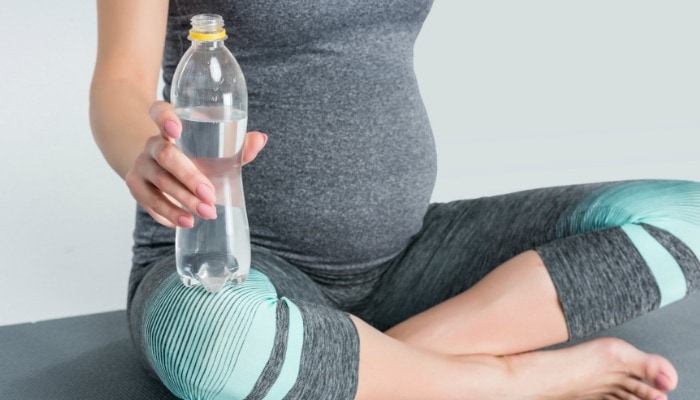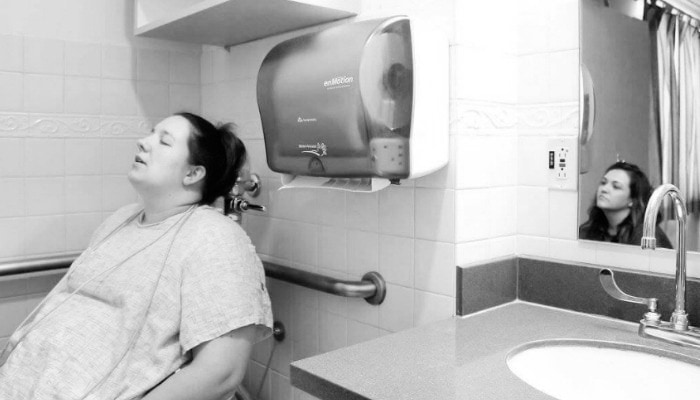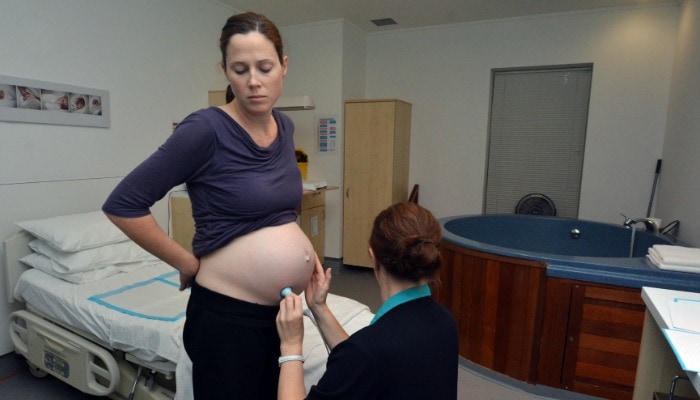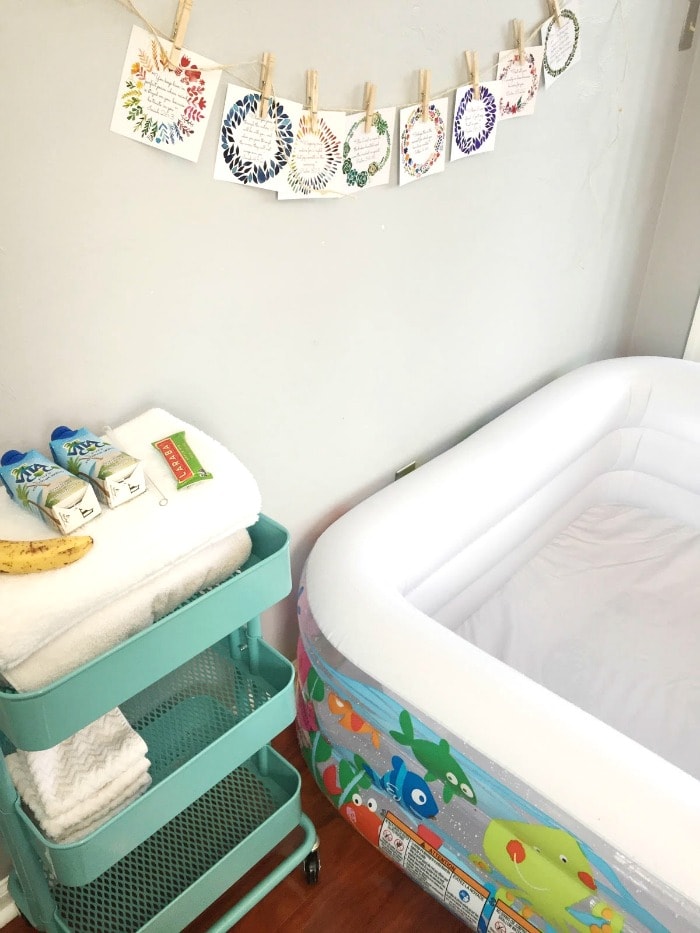When preparing for labor, so much of the focus is on coping through the pain of each contraction that parents forget about the gift of breaks between contractions.
Contractions are not constant, they come and go. During contractions women feel many sensations such as pressure and pain, but between contractions much of this goes away. This is good news!
In early labor, parents may have as many as 4-6 minutes between contractions (or more!). As things progress the break becomes less, but in active labor there’s still a whopping 2-4 minutes between contractions.

Parents Who Did This between Contractions Reduced Their Pain
So, what’s so special about the breaks between contractions? And what are some parents doing between contractions to ease their pain?
Parents that use the breaks between contractions wisely will likely experience less pain, a more enjoyable birth, and perhaps even a shorter labor!
(Before we get started and so we’re all on the same page, see if any of these related articles interest you.)
- What do contractions feel like?
- What do Braxton Hicks contractions feel like?
- What’s the difference between contractions and braxton hicks contractions?
- What are the signs of labor? Is it baby time?
- How far apart should contractions be before going to the hospital?
How to Take Advantage of the Break between Contractions
Other than keeping track of when one contraction ends and another begins, how can parents best use the break between contractions? The following are ways parents can take advantage of the breaks between contractions.
Tie Up Loose Ends
In early labor, contractions are around 5-7 minutes apart, 30 seconds long, and women are generally able to walk, talk, and continue on with much of normal, everyday life. Women may feel excited, nervous, relieved, and hopeful. At this point, there becomes a heavy emphasis on tying up loose ends so that when labor becomes more intense, parents can better focus on the task at hand.
Between contractions, parents may find it helpful to:
- Do a quick tidy around the house
- Finish laundry
- Notify places of employment
- Pay current or upcoming bills
- Take out the trash
- Return or exchange baby gifts
- Go for a quick grocery run
- Stock up on disposable paper goods
- Eat a delicious “last supper”
- Arrange for the care of pets and/or other children
- Finish packing the hospital bag for birth
- Take a final “before baby” photo or video

Sleep
Once any miscellaneous tasks are finished, parents are better able to focus on the task at hand. However, believe it or not, one of the best things to do in early labor is to sleep and rest as much as possible. Labor is typically long, and incredibly exhausting so resting on the onset is wise!
Even if contractions are coming every 5-7 minutes apart, continue to make rest a priority, especially if labor is happening at night. Turn off the lights, put away the electronics, and use the 20,000 pillows on the bed to get comfortable. During contractions, position yourself accordingly, but when they fade away let everything go and sink back into the bed.
If despite resting, labor continues to become longer, stronger, and closer together, it’s a good sign you’re in real labor!

Laugh
Some of my best memories during my homebirth were of laughing about silly things with my friends and family. Laughter makes us feel good, relax, lightens the mood, releases oxytocin, and creates fond memories of this special day.
Keep your humor, crack jokes with your partner, and as much as possible find the fun in the birthing experience. However, once she stops laughing, it’s best to move on to other things. 😉

Stay Hydrated
As a doula one of the things I typically do between contractions is offer my clients a sip of something. During contractions its pretty challenging to drink fluids, but between contractions is a wonderful time to prioritize hydration.
I often offer ice water, but occasionally it’s gatorade or coconut water, which are helpful with electrolytes and increasing energy. Make sure to drink 8 ounces of fluid per hour (between contractions)!

Take Bites of Food
Some parents want to know if they can eat between contractions. The answer is yes! Women absolutely benefit from eating and drinking throughout labor. (SOURCE)
During a contraction it can be difficult to chew and swallow food, so it’s best to wait to eat between contractions. Light foods like fruit salad, granola bars, and soups are some good foods to eat during labor.
Just remember, pick foods that wouldn’t be totally awful to throw back up later in labor (like hot wings… do not eat hot wings in early labor lol). Throwing up during labor can be pretty normal!
Go to the Bathroom
What goes in must come out, right? 😉 Many parents want to know if they can poop between contractions. The answer is yes! There is a lot of pooping and peeing that happens during labor. Emptying the bowels is even a sign of labor coming!
Benefits of going to the bathroom between contractions are
- The more you poop during labor the less you’ll poop during pushing
- An empty bladder makes space for a baby to drop lower into the pelvis
- Laboring in the bathroom encourages the birthing process to move forward

Give and Receive Affection
To giving and receive affection from a partner or other loved one is a wonderful thing to do between contractions. Connecting with one’s partner through empathetic touchcan be extremely grounding, relaxing, and can literally decrease pain!
Hugging, kissing, touching, massage, etc. all encourage the release of the hormone oxytocin, which is a feel good bonding hormone. Oxytocin is also an important hormone of labor! Oxytocin causes contractions to become longer, stronger, and closer together – which is what we want!
Connect with Older Children
It can be comforting for a laboring woman to connect with her older children between contractions. Parents may talk about the new baby, the children’s plans for the day, or spend time hugging and kissing their little ones. These can be very bittersweet moments.
Connecting with older children is best done in early labor. As labor progresses, all of a woman’s energy and focus becomes turned towards labor. It becomes quite difficult to do anything extra!
Of course, sometimes children hanging out with their laboring mom could be a bad idea. There’s no “right way” of doing this!


Connect with Baby
Another thing for parents to do between contractions is to check in and connect with their baby. Sometimes, with everything that happens during labor, it’s easy to forget that babies have their own birth experience too.
Will baby move between contractions? Yes! (And sometimes their kicks cause more contractions. Fun! 😉 ) When you notice baby kicking or moving between contractions, this may be a good time to connect with baby.
Make Eye Contact with Partner
Making eye contact with your partner or other loved ones is a really good thing to try between contractions. Eye contact encourages oxytocin to be released, the body to relax, and the sensations of pain to reduce.
Go ahead and give it a try during pregnancy! It’s a wonderful thing.

Drop the Shoulders
It is instinctual to tense up and recoil when the body experiences pain. This is the body’s way of protecting and getting us away from danger. However, the pains of labor aren’t dangerous. In fact, they’re quite normal and a good thing! Remember, labor brings a beautiful, new baby.
In the same way, if you don’t know what to expect during contractions or are caught off guard by the sensations of labor, it can be instinctual to recoil and tense up. However, one of the ways to experience less pain during contractions is to do the opposite – relax and allow the body to do what it knows to do.
Sometimes, especially during a rip roarin’ labor, despite a woman’s best intentions, she becomes somewhat tense during contractions. It happens! If you find yourself tensing up, make a special effort to relax the body when contractions fade away.

Get a Massage
Massage is a great way to take advantage of the time between contractions. The goal here is to encourage as much relaxation as possible. It’s totally possible!
Some women don’t like to be touched during contractions, but most love some sort of physical touch in between!
A good place to start a massage are the body parts mentioned above – the shoulders, face, and hands. Also, the back and hips are usually aching for some TLC. You could even try a foot massage!

Take Deep Cleansing Breaths
Another way to release tension between contractions is to take deep cleansing breaths, and on the exhale “let everything go”. Remember, the contraction that you just experienced is gone – you never have to do that one again!
Breath Awareness
Speaking of our breath, a wonderful thing to do between contractions is to focus on the breath, which is a wonderful labor breathing technique.
In my childbirth classes I teach the best labor breathing technique (I’m slightly biased 😉 ). It’s extremely effective, it’s easy to learn on the spot in labor, and can carry a women through the bulk of her labor and delivery.
Not only is this labor breathing technique excellent for a natural birth, but it’s also amazing for a medicated or even a cesarean birth. No matter what type of birth you are planning, this simple and effective labor breathing technique is for you.
Head on over here to learn all about breath awareness!
Doze Off
When thinking about the amount of time spent during labor, some parents wonder if it’s possible to sleep between contractions, even late in labor. The answer is yes! In fact, if it’s in any way possible, I highly recommend it!
The thing is, sure, one of the biggest challenges of labor is the pain of contractions, but it’s also battling exhaustion. Exhaustion is ROUGH when paired with labor.
To effectively battle exhaustion take advantage of any breaks your body allows. Especially in longer labors, position yourself in bed, or the tub, for 30-60 minutes to attempt to doze off between contractions.
Sometimes, right before pushing, I’ve seen a woman’s transition contractions slightly space out to around 4-5 minutes apart. In these instances the mom was able to doze off for just a few minutes, and woke back up again with the next contraction. It was wonderful and much needed!

Express Feelings
Birth is not just a medical event! Pregnancy, childbirth, and postpartum is an emotional, physical, and spiritual experience. Having a baby impacts the whole person.
Because of this, it makes sense that parents will have intense feelings arise throughout labor. This is normal!
When this happens, express yourself to a safe person on your birth team. It’s helpful to release these feelings, but it’s also a good thing for others to keep you on track.
At one birth I heard a mama once say, “I’m afraid something’s going to break” to which her midwife replied that “nothing’s going to break”. Her words were very reassuring!
Express Gratitude
Complaining never has the effect we are hoping for. It doesn’t make us feel better, and has the ability to pull us down even further than before.
I remember during my third birth I was at the end of my rope and nothing was working anymore. Nothing, not even my doula. It was at that point I decided to stop complaining and instead be silent. Everything changed after that. My contractions spaced out a little bit and I was better able to cope.
I think when parents stop complaining (remember, it doesn’t help us out!) but then take it a step further and express gratitude, they have the ability to experience less pain, and have a more enjoyable birth. (And yes, women have the ability to speak between contractions!)
Between contractions, try telling someone what you’re thankful for. It can be super simple! You could be grateful for…
- The end of pregnancy
- Contractions that bring a new baby
- Getting to meet your new baby soon
- The support of your birth team
- Crunchy ice
- The tub or shower
- Music
- Aromatherapy
- Massage
- The weather

Take a Mental Snapshot
Another sweet thing to do between contractions is to take a mental snapshot of a particular moment. What I mean by mental snapshot is, to intentionally stop whatever you’re doing and try to notice what’s happening in order to solidify it in the memory.
Pay close attention to what you see, hear, touch (or what’s touching you), smell (maybe), and then breath it all in. While noticing these things, sometimes it also helps to say something like, “I will remember this moment.”
Read and Speak Birth Affirmations
One way women can meet the physical, mental, and emotional challenges of birth is by reading birth affirmations between contractions to feel more encouraged, confident, and positive.
I love birth affirmations! In fact, I even made printable birth affirmations which I used for one of my births.
These visual affirmations helped me gain confidence. Even though I taught childbirth classes and was a doula, I was still human. I was definitely daunted by the task at hand!
Receive Encouragement and Praise
Not only is it helpful to speak words of affirmation to oneself, it’s also helpful to receive encouragement and praise from those on the birth team. A doula, partner, mother, sister, or friend may say things like “you can do it” and “you’re doing so well” as a way to support a woman through labor.
Between contractions, receive these kind words and believe them as true. You are doing it! And you are doing so, so well!
Curious about what not to say to a woman in labor? Wondering what’s helpful to say between or during contractions? Hop on over here to find out how to effectively speak to a laboring woman.
Check-In with Birth Team
Speaking of the birth team, between contractions is a good time to check-in and evaluate how things are going. Women may have questions for their care provider about labor or about the welfare of their baby. They may wonder if the position they’re in is working, or if they’re “doing it right”. And of course, parents will likely want to know “are we there yet?” 😉

Ask for Help
When checking in with your support team between contractions, make sure to ask for help if and when it’s needed. If you’re feeling overwhelmed, need to talk something through, or maybe something isn’t quite right, ask for help.
Maybe you need help finding different music to listen to, or to get in and out of the tub. Make your wishes known! If on any day you get to ask for help, today’s the day.
Try a New Position
Another thing to do between contractions is to try a new position. During contractions is probably the worse time to try to move and try something new, but between contractions, that’s when women should move.
Sometimes moving causes contractions. Logically speaking, this may mean women won’t want to move for the rest of labor. But be brave because changing positions and moving throughout labor can often make labor progress faster and help decrease pain.
Parents Who Did This between Contractions Reduced Their Pain
Taking advantage of the time between contractions can be a game changer for parents in labor. Contractions come and go, and by using the time between wisely, labor will be less painful and perhaps even shorter!
To recap, try the following activities when not having contractions:
- Tie Up Loose Ends
- Sleep
- Laugh
- Stay Hydrated
- Take Bites of Food
- Go to the Bathroom
- Give and Receive Affection
- Connect with Older Children
- Connect with Baby
- Make Eye Contact with Partner
- Drop the Shoulders
- Get a Massage
- Take Deep Cleansing Breaths
- Breath Awareness
- Doze Off
- Express Feelings
- Express Gratitude
- Take a Mental Snapshot
- Read and Speak Birth Affirmations
- Receive Encouragement and Praise
- Check-In with Birth Team
- Ask for Help
- Try a New Position
What did you do between contractions? What worked and what didn’t work? Leave a comment and let us know. Thanks!

